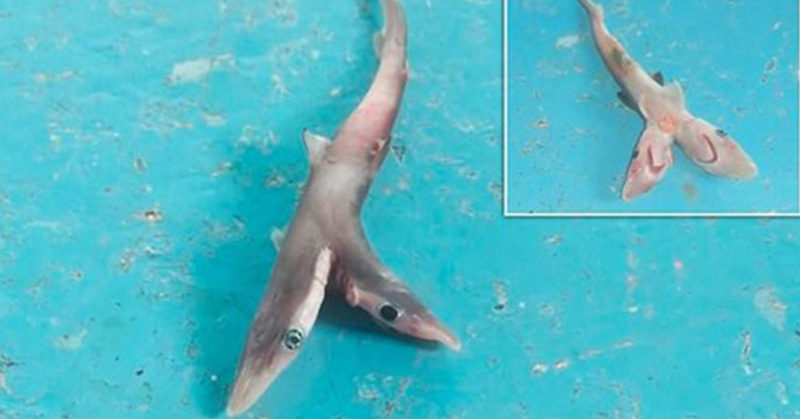Thought two-headed sharks are made-up creatures from sci-fi films? Think again. A fisherman pulled a baby mutant shark out of the water off the coast of Western India, and it’s not the first of its kind.
Mutant Shark Found in India
Nitin Patel, a fisherman in Maharashtra, India, had a shock when he hauled in a two-headed baby shark along with his daily catch. He snapped a photo of the mutant shark before tossing it back into the ocean. (1)
“We do not eat such small fish, especially sharks, so I thought it was strange but decided to throw it anyway,” he explained. (1)
At the time, he didn’t realize how rare and special his find was. These two-headed sharks, however, are becoming increasingly common. (1)
Other Mutant Shark Sightings
In India, two other two-headed sharks have been reported in the past (1):
- In Gujarat, 1964
- Karnataka,1991
According to Dr. KV Akhilesh of the Indian Council for Agricultural Research – Central Marine Fisheries Research Institute, other sitings have occurred but were not photographed or recorded. (1)
Mutant sharks have been seen in other areas, as well, including (2):
- A bull shark in Florida who’s uterus held a two-headed fetus
- A two-headed blue shark embryo in the Indian Ocean in 2008
- Conjoined blue shark twins in the Gulf of California and Northwestern Mexico in 2011
- A two-headed embryo in the eggs of an Atlantic saw tail catshark in a laboratory setting, the first shark to lay eggs
- A small eye smooth-hound shark and a blue shark found off the coast of Margarita Island in Venezuela
As these mutant sharks becoming increasingly more common, scientists are scrambling to figure out why. (2)
Read: Walking Sharks That Can Leave The Water Discovered In Indo-Australian Archipelago
Why do Mutant Sharks Exist?
It is difficult for scientists to determine what would exactly cause this kind of mutation in sharks because they have so few specimens to study. (2)
According to Valentín Sans-Coma, lead researcher for a mutant shark study in The Journal of Fish Biology, genetic disorder is likely the most plausible cause in their study. This is primarily because their embryo was grown in a lab along with 800 other specimens. (2)
The mutations in wild sharks, however, have a much broader potential for possible causes. These include (2):
- Viral infections
- Metabolic disorders
- Pollution
- Shrinking gene pool due to overfishing leading to inbreeding and genetic abnormalities
These sharks typically don’t survive, either, because of deformities that make it difficult to survive in the wild. (2) For example, the mutant shark found in Maharashtra had deformed eyes on one of its heads and two first dorsal fins. (1)
As more of these are recorded in journals rather than just tossed away, perhaps the mystery of how and why they are formed will be revealed.

